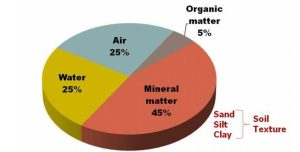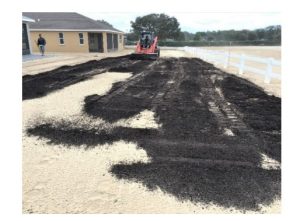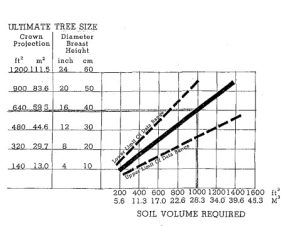Healthy trees and lawns required healthy urban soils! What are the main characteristics of a good soil? A good soil contains 45% mineral matter, 25% water, 25% air and 5% organic matter (figure 1). It’s difficult to find those characteristics in urban soil, because the soils are almost always too compacted, meaning the level of air is very low, the texture and structure is very bad, and the percentage of organic matter and the water holding capacity are very low. The term urban soil refers to soil in areas of high population density in highly populated areas built. They contain a man-made surface layer of more than 20 inches thick, that has been produced by mixing, filling, or by contamination of land surface in urban and suburban areas.

How can we fix the problem? There are some solutions, unfortunately, they are not cheap. As UF/IFAS Dr. Eban Bean’s research shows, incorporating compost could help increase the organic matter, lower the soil density, and increase the water holding capacity. For the best results, compost should be incorporated into the soil at a depth of at least six inches. The recommended application rate is 4 cubic yards per 1,000 square feet. (figure 2 and 3).


In urban setting, trees also need to overcome the amount of soil space they need to grow to their full potential. The question of how many cubic feet of soil a tree needs to survive was addressed by the landscape architect James Urban in his 1992 article in the Journal of Arboriculture “Bringing order to the technical dysfunction within the urban forest” . In the article, he mentions that 1,000 ft3 of soil are required for the tree to develop 640 ft2 of crown projection and 16 inches of DBH (diameter breast height).

As you can see, planting a tree in the urban setting requires some understanding of the soil characteristics. Correcting the soil deficiencies before planting will ensure that the plants are going to grow to their full potential.
References
Eban Bean, Example ordinance for compost amending soil in urban landscaping.
https://edis.ifas.ufl.edu/publication/AE566
Eban Bean, et. Al. 2020. Guidance for Amending Soils with Organic Amendments.
James Urban, 1992. Bringing order to the technical dysfunction within the urban forest. Journal of Arboriculture. https://static1.squarespace.com/static/52ec31b2e4b04eb0bbd9c075/t/5339ee00e4b029d638529446/1396305408895/Bringing+Order+to+the+Technical+Dysfunction+within+the+Urban+Forest.pdf
Maechling, P., Cooke, H. and Bockheim, J.G. 1974. Nature and properties of highly disturbed urban soils. p. 151. In Agronomy abstracts. ASA, CSSA, SSSA, Madison, WI
 1
1
